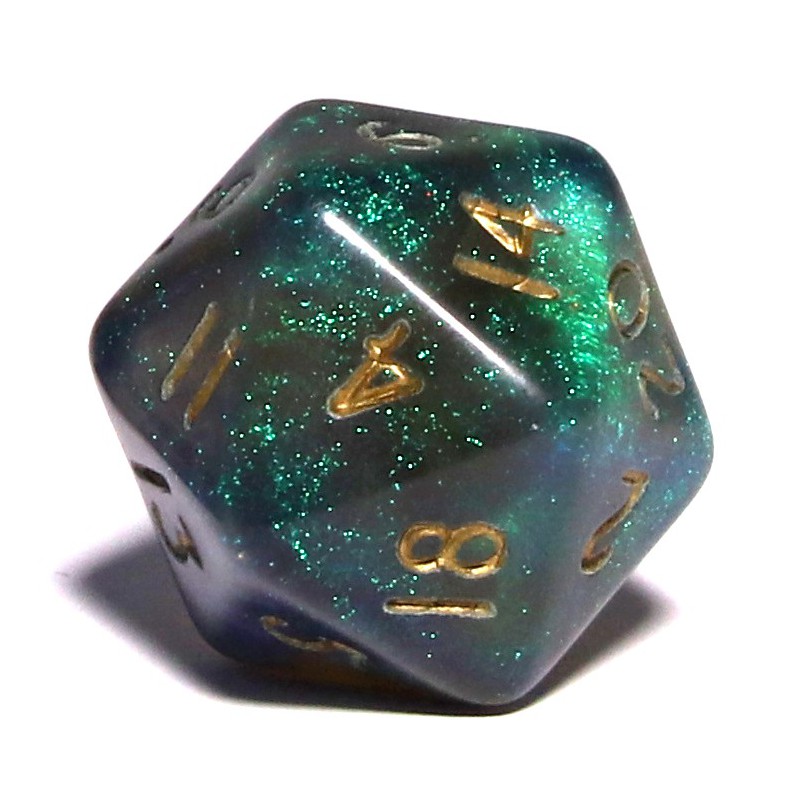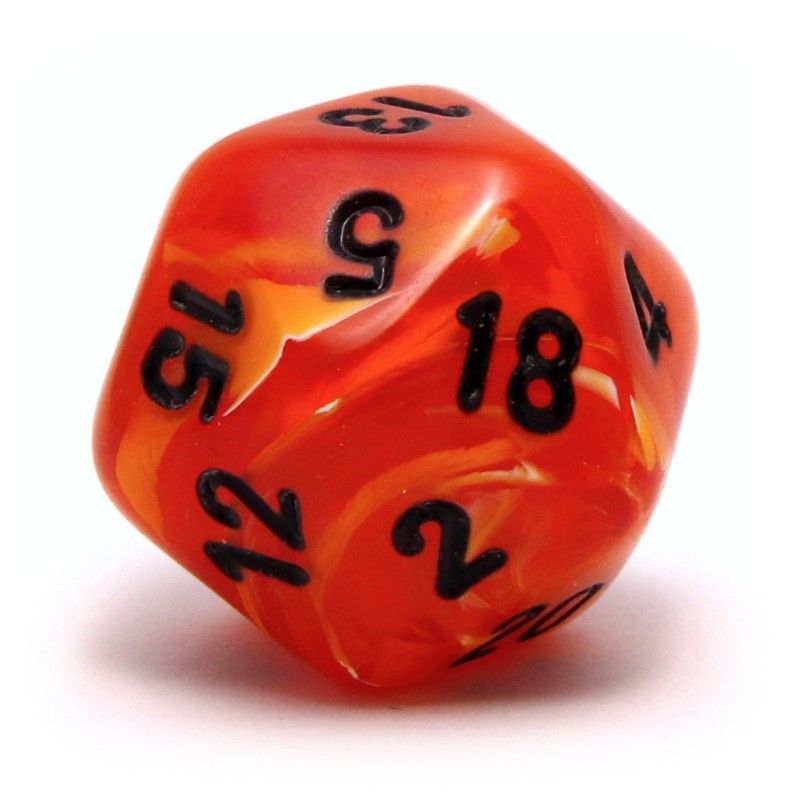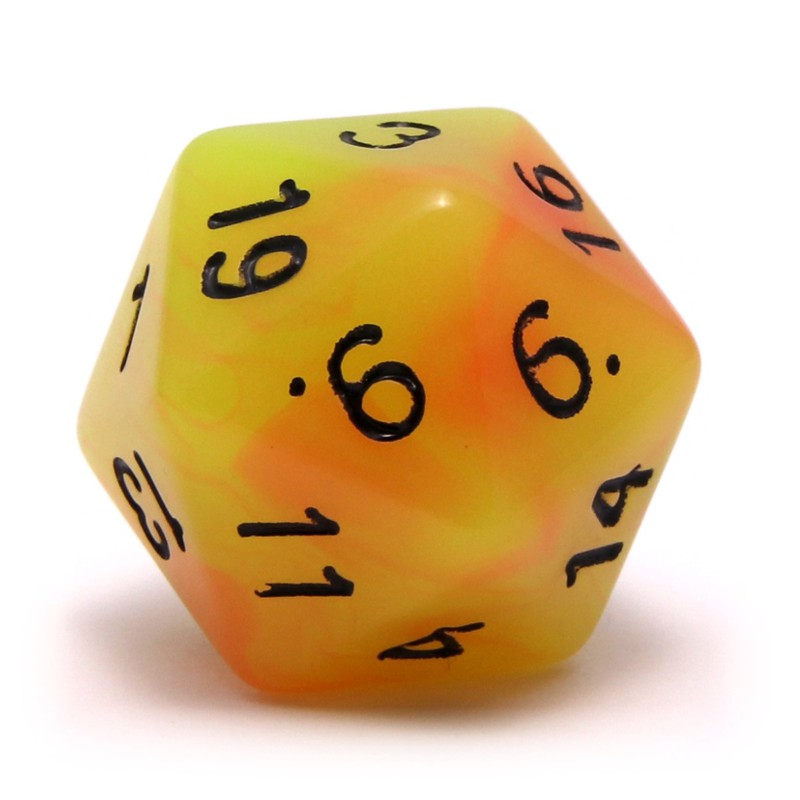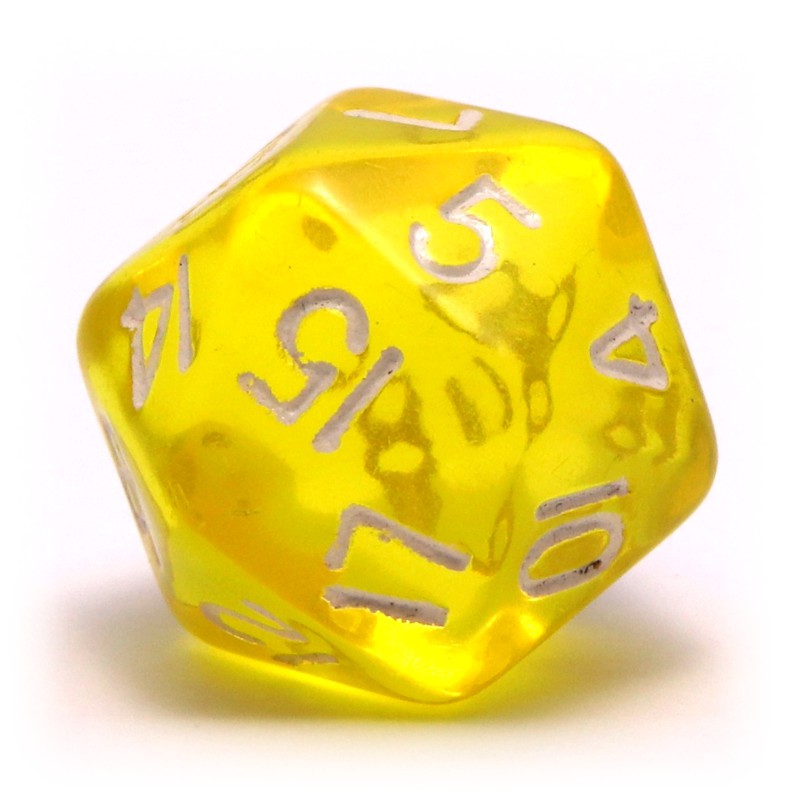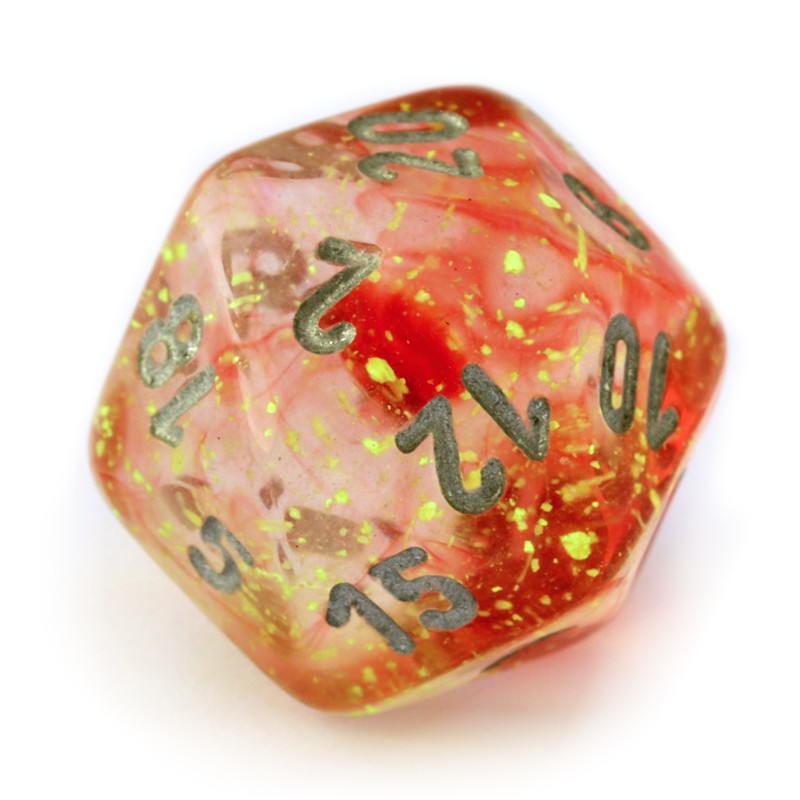Colours
Dice come in hundreds of different colours and colour combinations, and it will be impossible to list general rules here for how to identify a die from their colour or colour combination alone. Very often, the identification of a die starts with pinning down what manufacturer it is from the mould that was used. Once you have the manufacturer figured out, it gets easier to narrow down what die exactly it might be by then looking at the colour and design, material or mix.
There are some colour combinations or ways to mix materials that are commonly seen, and they are often called differently by different manufacturers. I cannot give you an exhaustive list, but I will try to show a few popular designs and frequently used names for them.
Design
Clear or translucent die base with a swirly infusion of colour, similar to the effect when you drip ink into a clear liquid
Name Examples
Nebula (Chessex, HD), Diffusion (Role4Initiative), Ethereal (Kraken)
Fine glitter with an iridescent or colour-shifting effect in a translucent or semi-translucent die base
Borealis (Chessex) Moonstone (Crystal Caste, Die Hard Dice, Bescon), Fire Opal (Crystal Caste), Iridescent (HD), Aurora (HD), Luminous (HD), Frozen (Ogopogo), Shimmery (Bescon), Glitter (Udixi)
Clear, translucent or semi-translucent die base with several colours that are all swirled together
Festive (Chessex), Rainbow (Chessex), Muse (HD), Marble (King Cards), Magma (D&G), Spectrum (Crystal Caste)
Clear, translucent or semi-translucent die base with an additional one or two colours that are swirled together
Vortex (Chessex), Cirrus (Chessex), Leaf (Chessex), Silk (Crystal Caste), Dragon Bones (Crystal Caste)
Semi-translucent die base with metallic material mixed or swirled in
Gold Mist (D&G), Ancient (Crystal Caste)
Two-colour mix with a relatively equal spread of both colours
Gemini (Chessex), Blend (HD), Jade (HD), Marble (D&G, T&G)
More distinct opaque, translucent, semi-translucent (or a mix of them) layers stacked on top of each other in different colour combinations
Layered (HD, Kraken), Mineral Rocks (Bescon)
Opaque or milky die base that glows in the dark (although some dice like Chessex Luminary only have smaller glow-in-the-dark particles)
Glo-Dice (Chessex), Glow in the Dark (HD)
Unicoloured, opaque without any patterns
Opaque, sometimes given descriptive names depending on colour (e.g. Enchanted Clay, Dreamless Night, etc.)
Unicoloured or two-tone translucent dice
Translucent (Chessex, Crystal Caste, HD), Gemini Translucent (Chessex), Gem (D&G), Firefly (Crystal Caste), Gem Blitz (D&G)
Unicoloured translucent die base with a rougher, frosted surface
Frosted (Chessex, Wiz Dice), Sea Glass (Kraken)
Opaque, usually unicoloured die base with a pearly surface sheen
Pearl (Chessex, Crystal Caste, D&G, HD, King Cards)
Opaque die base with speckles in either one or several colours interspersed equally throughout the die
Speckled (Chessex), Two Toned (Koplow)
Clear or translucent die base with solid particles mixed in (e.g. more coarse glitter, gold foil, foil shapes)
Sparkle (Chessex), Glitter (Chessex, T&G, HD), Particles (HD), Confetti, Gold Foil, Gold Leaf, Butterfly, etc.
Clear or semi-translucent dice with glow-in-the-dark particles inside
Luminary (Chessex), Glowworm (Sirius Dice)
Ink
Ink is one of the most variable and easiest to change features of a die, to the point where some collectors like to change the ink colour themselves (a process called reinking). This can be done in several different ways, please refer to this DMC blog entry that covers the topic in more detail.
In most cases, a dice line only comes from the manufacturer in one ink colour, although there are also exceptions to that rule (one example being Ogopogo’s Frozen line that comes in four different ink colours). Frequently used colours are black, white, gold and silver. Sometimes ink colours get changed over time for the same dice line (e.g. Chessex Velvet with gold, which later changed to silver).
The colour combination of a die, its material and the ink colour can help in identifying similar looking dice, e.g. Chessex Cirrus Light Blue (which has white ink) and Chessex Luminary Sky (which has silver ink). However, please be aware that used dice may have been reinked by the previous owner, so ink colour is not always a good indicator if you are looking for ID on used dice.
Feel and Weight
This is perhaps a no-brainer, but the material of a die can also easily determine ID, e.g. plastic vs. metal dice. However, there are also cases where this is not as clearly determined by visual means only, for instance for the Chessex Opaque dice, which are made from urea rather than resin or acrylic. Urea dice feel colder to the touch, and have more heft to them than acrylic or resin dice. Chessex Speckled dice are also made from urea. Chessex also recently released a new line in one of their Lab Dice waves called ‘Heavy Dice’ that are indeed heavier than regular acrylic dice, and even heavier than urea dice.
Identification of Pipped Dice
Identifying pipped dice is a little more difficult, since we don’t have the advantage of seeing differences in font. There are different moulds with a different orientation of the sides and where they are placed in relation to each other. One example of orientation is RH030, which is commonly used by Chessex for their 16mm pipped d6. You can learn more about the orientations and what they look like on the Lord of the Dice website.
In most cases, where identification of pipped dice is concerned, it comes down to recognizing the combination of material, design, die material colour(s) and ink colour, sometimes also the size of the die or where on the die face the pips are placed. A lot of veteran or knowledgeable dice collectors will be able to tell you what pipped die it is from just looking at it, but if you’re not there yet, don’t worry, one day you might be.
In Summary
Now that you have all this information, how does that help you actually IDing your dice? First recommendation is to start with the mould. Find out if it’s Chessex, Crystal Caste, Wiz Dice, HD or something else.
Once you have (hopefully) determined what manufacturer it is, you should take a closer look at the colour combination or finish or just overall design. Are the dice opaque, translucent, uni- or multi-coloured? Some manufacturers don’t have that many different designs, which makes it easier to narrow down the ID. Others, like Chessex, have a multitude of designs, and it then helps to look at resources like the Dice DB or manufacturers’ websites to compare against photos of the different lines.
It also helps to have a general feeling for what the different Chessex lines look like (e.g. Festive and Vortex are swirly, Gemini are two-coloured, Phantom are milky, Borealis are glittery), which in time you will learn if you actively follow the dice collecting community.
Lastly, if you’re not sure about the ID of your dice, it can also help to look at the ink colour and check against existing databases or photos if your ink colour matches the photos online.
And of course, if all else fails, you can take pictures of your dice and post them in the Dice Maniacs Club Facebook group or Discord server, asking for an ID. There’s always someone happy to help, and often very quick at it, too.
Helpful Resources
- Michael Schäffer’s Dice DB (incl. dice moulds information)
- Kevin Cook’s Dice Collection website
- Jon Peterson’s ‘Identifying 1970’s Dice’ YouTube video and blog post
- Daniel L.’s Licensed D&D Dice Guide
- HD website #1, HD website #2
- Mel Shaw’s HD Dice Comparison Spreadsheet
- Bescon website
- Chessex website
- Crystal Caste website
- Dice & Games website
- GameScience website
- Koplow website
- Kraken website
- Q-Workshop website
- T&G website
- Wiz Dice website
- Chessex Borealis Glitter Identification Guide
- Crystal Caste Silk vs. D&G Marble Identification Guide
- Kevin Cook’s dice mould identification guide
- Michael Schäffer’s Dice DB page on dice moulds
- Orientation guide for pipped d6 by Lord of the Dice
Pages:
- 1
- 2


